9.06.2024
SpaceX Starship successfully returns from space on fourth test flight
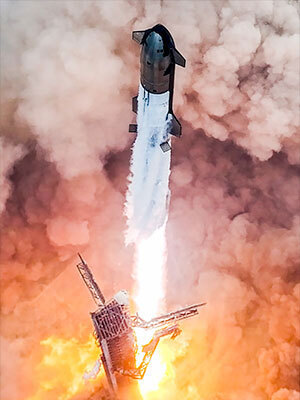
A Starship and Super Heavy booster lifts off on a test flight from SpaceX's Starbase in Texas on Thursday, June 6, 2024, (SpaceX)
Proving what goes up can come down, SpaceX accoplished its first fully-complete test flight of its Starship on Thursday (June 6), returning both the booster and spacecraft to splashdowns.
The successful hour-long suborbital flight came on SpaceX's fourth attempt to launch Starship, reach space and return to Earth intact. The prior test in Marchaccomplished the ascent but did not survive reentry.
"From South Texas to the other side of the Earth, Starship is in the water. What a day.," said Dan Huot, SpaceX's communications manager, who helped provide commentary on the company's live webcast of the launch.
Thursday's flight began at 7:50 a.m. CDT (1250 GMT) with the liftoff of the nearly 400-foot-tall (121-meter) Starship from SpaceX's Starbase launch facility in Boca Chica, Texas. The vehicle's Super Heavy booster lit all but one of its 33 Raptor engines, beginning its climb skyward.
About two minutes and 45 seconds into the flight, the Super Heavy cut off most of its engines, the Starship spacecraft riding atop the booster ignited its engines and then two vehicles separated in a hot stage maneuver.
The Super Heavy then relit 13 of its engines to perform a "boostback burn," propelling it back towards Texas' coast, setting up its splashdown in the Gulf of Mexico. The booster next jettisoned its hot stage, the segment of the rocket that spanned between it and Starship. Future versions of the Super Heavy will have a lighter, integrated structure, but for this flight the stage had to be separated to lower the weight of the returning booster.
Still falling back to Earth while using four hypersonic grid fins to guide its way down, the Super Heavy performed a landing burn, firing 12 of the 13 engines planned, slowing its vertical descent to make a soft touchdown in the water. A camera view from on board the booster showed it tipping over into the gulf as it completed its flight about seven minutes after its launch.
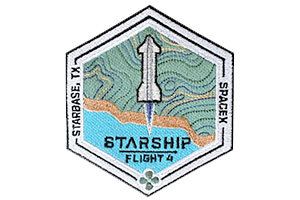
Meanwhile, Starship continued climbing for another minute before cutting off its engines and coasting for 40 minutes to demonstrate its orbital ability and set up its targeted return to the Indian Ocean.
At about 48 minutes into the flight, Starship began its reentry, using the friction generated by Earth's atmosphere to slow its velocity as it descended. Relaying its video signal through SpaceX's Starlink broadband satellite network, live camera views showed plasma being built up around the spacecraft.
For this flight, SpaceX purposely removed two of its heat shield tiles to measure the effects of reentry on the ship's steel body using sensors to record the data.
Despite some clear damage to its structure on its way down — one of the ship's steering flaps looked to be close to having being burned off — Starship made it through the reentry and fired its engines for a landing burn before splashing down off the northern tip of Australia.
"Despite loss of many tiles and a damaged flap, Starship made it all the way to a soft landing in the ocean!" exclaimed Elon Musk, SpaceX's founder and CEO, in a post on the X social media network. "Congratulations [to the] SpaceX team on an epic achievement!!"
SpaceX did not plan to recover either Starship or Super Heavy, letting them both sink to their respective sea floors. When the vehicle is operational, the company plans for both the booster and spacecraft to return to their launch pad, touching down where they previously lifted off to enable "rapid and reliable reusability" of the full system.
SpaceX is developing Starship to ultimately fly humans to Mars, but first will use the vehicle to complete the deployment of its Starlink constellation and serve as a human landing system for NASA's first Artemis missions to return astronauts to the moon's surface.
Quelle: CS
----
Update: 14.06.2024
.
FAA, NASA seek public input on SpaceX Starship launches at the Kennedy Space Center
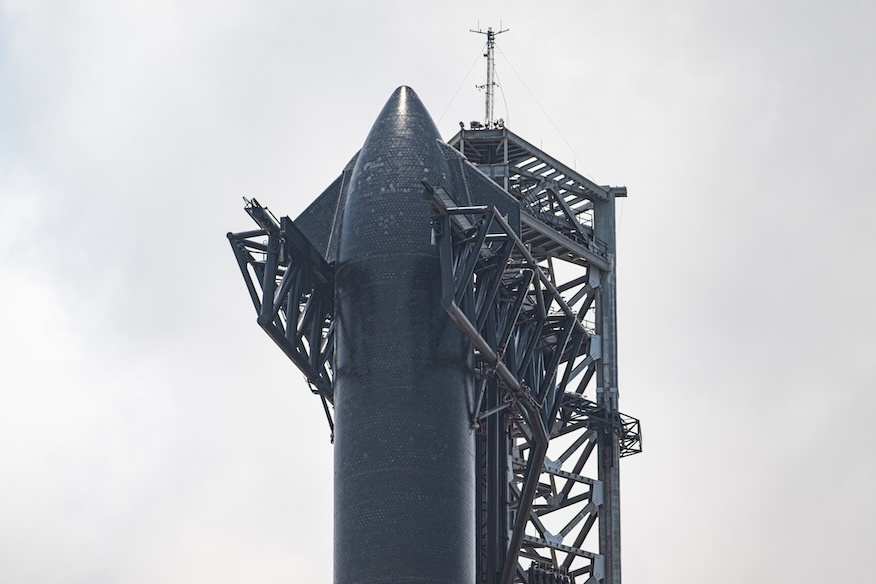
The Ship 29 upper stage of the fully integrated Starship rocket as seen before its fourth flight test on June 6, 2024. Image: Michael Cain/Spaceflight Now
The Federal Aviation Administration is preparing to gather public input on SpaceX Starship launch operations at NASA’s Kennedy Space Center. The request for comments comes about a month after the conclusion of an environmental review of a 100-acre expansion for SpaceX at its Hangar X site.
The pair of projects highlight an ongoing ramp up of activity for a company that aims to launch more than 140 Falcon launches by the end of 2024, most of them from Florida’s Space Coast.
“SpaceX draws a lot of attention. There’s no question about it. They’re doing a lot of amazing things and they draw a lot of attention from the public, not just locally or regionally, but worldwide,” said Don Dankert, the technical lead of the Environmental Management Branch at NASA’s Kennedy Space Center.
On June 12 and 13, the Federal Aviation Administration (FAA) will host a series of public scoping meetings to inform the public and answer questions about SpaceX’s proposal to launch Starship from Launch Complex 39A (LC-39A). There will also be a virtual meeting on June 17 for those unable to attend in person.
- June 12 – 2-4 p.m. ET, 6-8 p.m. ET at the Radisson Cape Canaveral, 8701 Astronaut Blvd, Cape Canaveral, Florida 32920
- June 13 – 6-8 p.m. ET at the Kennedy Space Center Visitor Complex, Space Commerce Way, Merritt Island, Florida 32953
- June 17 – Virtual
- Zoom Link URL: https://us06web.zoom.us/j/89402979916
- ZOOM Meeting ID: 894 0297 9916
- Call-in number options (all toll-free): 833-928-4608, 833-928-4609, or 833-928-4610
Among those attending the public hearings will be representative of the Department of the Air Force, the U.S. Space Force, the U.S. Coast Guard, U.S. Fish and Wildlife Service, the Merritt Island National Wildlife Refuge, Canaveral National Seashore and SpaceX.

“Through scoping, you introduce the project to the public at large and others and you take that feedback and that’s really how we find that out: what are those key issues? What are the things, what are those areas that the public may have an elevated level of concern about?” Dankert said. “And that in turn will drive us to say, ‘Ok, we need to take a much harder look at this or delve in or maybe we didn’t consider that.”
Through the environmental impact statement (EIS) process, the FAA will lead a review of impacts from SpaceX Starship operations across a number of areas including air quality, coastal resources, land use, noise and water resources, among others.
The assessment is a follow-up to an EA prepared in 2019 for Starship launches.
“Since that time, there’s been changes in the vehicle configuration, the concept of operations, the infrastructure needs. And when SpaceX approached us with this, obviously they need an FAA license in order to operate at 39A at KSC,” Dankert said. “In looking at it, we scoped it as an EIS (environmental impact statement). In some sense, it will supplement or continue that analysis that we started in 2019.”
He said NASA requested that the FAA take on the role of the lead federal agency in this process, since they’re in charge of launch licenses.
“I think it gives us greater reliability and buys down some of the risk. The FAA is going to have exactly what they need to do their evaluation when it comes time for the licensing action,” Dankert explained. “KSC is what we call a ‘cooperating agency’ in the development of that document. So, we are fully engaged.”

Back in 2019, SpaceX’s proposal was for 24 Starship launches per year, but with a different-looking Starship rocket. Back then, it was thought the upper stage would consist of seven Raptor engines and would land on either Landing Zone 1 (LZ-1) at Cape Canaveral Space Force Station (CCSFS) or on a droneship.
Meanwhile, the Super Heavy booster would consist of 31 Raptor engines and land on a droneship as well. There were no plans at the time for the booster to return for a landing at LC-39A.
“SpaceX now proposes to construct additional launch infrastructure not previously contemplated in the 2019 EA: a Super Heavy booster catch tower, a natural gas liquefaction system and air separation unit for propellant generation, and stormwater/deluge ponds,” the FAA wrote. It added in a separate document that SpaceX would likely use about 1 million gallons of deluge water per launch attempt.
“SpaceX also proposes to launch an advanced design of the Starship and Super Heavy vehicle (up to nine raptor engines for Starship and up to 35 raptor engines for the Super Heavy booster), operate at a projected higher launch tempo (up to 44 launches per year), and land the Super Heavy booster at LC-39A in support of its reusability concept. Starship landings are no longer proposed to occur at Landing Zone 1 at CCSFS.”

The new proposal would also give SpaceX the option to land the booster either at LC-39A, on a droneship, or expend it at least five nautical miles off the coast. A similar environmental assessment is being conducted by the Department of the Air Force for Starship operations at Space Launch Complex 37, the former home of United Launch Alliance’s Delta 4 Heavy rocket.
In an FAA document outlining the proposal from SpaceX, the agency said there is no alternative option that is a reasonable change of course from the primary proposal. It argued that “the only alternative to the Proposed Action as described in this EIS is the No Action Alternative.”
“LC-39A could provide time-critical mission capability to NASA for near-term lunar exploration on the NASA Artemis and Human Landing System programs,” the FAA wrote. “In addition to NASA’s mission-critical requirements, LC-39A would provide launch site diversity for Starship-Super Heavy to serve commercial exploration interests.”
The FAA also offered a glimpse into the future versions of the fully integrated Starship rocket, stating that it “is expected to be up to 492 feet (150 meters) tall depending on configuration and approximately 30 feet in diameter.” That’s in comparison to the vehicle launching today, which is only 397 feet (121 meters) tall.
The document also states that the upgraded version of Starship will include 35 Raptor engines for the Super Heavy booster and nine for the upper stage.

100-acre no more woods
In addition to the Starship launch proposal, KSC has been busy with another SpaceX request. Dankert’s office spent the better part of two years reviewing a proposal from SpaceX to extend their main footprint at KSC, known as at the Roberts Road campus, by 100 acres.
Under an environmental assessment (EA) approved in 2018, SpaceX has been making notable expansions and improvements within its current 67 acres, but this new expansion aims to bring the majority of its assets around Brevard County to this one spot.

As is the case for any infrastructure project at KSC, that meant undergoing the federally mandated NEPA (National Environmental Policy Act) review. Part of that involves calling for public opinion on the general proposal near the start of the assessment and then calling for public comment once again once a draft EA is issued.
“We put the document out, publish it on the website and give the public at large, including all of our stakeholder agencies and others, an opportunity to read the document, look at the post-findings, and then provide formal comment back to the agency for us and SpaceX to consider in the development of the final document,” Dankert said.
After doing their due diligence and considering all of the feedback, this spring, NASA issued a FONSI(finding of no significant impact), which paves the way for SpaceX to move forward with its expansion plans. The next step in that process is for SpaceX to establish a lease agreement with KSC.
“That is in work, in the final stages of executing that actual agreement between NASA and SpaceX,” Dankert said.
The transformation of this hundred acre plot of land won’t be a quick process. Part of SpaceX’s ability to develop the space will be submitting a site plan to NASA “with additional details on building dimensions and site layout,” according to the FONSI document.
“The KSC site plan review process identifies potential constraints including land use, operational conflicts, natural resources, line-of-sight, safety, and security, and ensures that the SpaceX plan complies with this SEA,” the document stated. “SpaceX would implement changes as required by NASA.”
Details of SpaceX’s future expansion remain largely held to the chest, but the documentation does provide some crumbs of information. For instance, in the biological opinion, prepared by the U.S. Fish and Wildlife Service’s (FWS) Florida Ecological Services Field Office (FESFO), there are references to buildings that will stand as tall as 400 feet.
“The Action proposes the construction of multiple towers up to 400 feet in height,” Robert Carey, manager of the Division of Environmental Review in the FESFO, wrote in his report. “Thought the Action is located approximately six miles from the closest nesting beach, the height of these towers has the potential to be seen by nesting sea turtles during the sea turtle nesting season.”
For reference, the Statue of Liberty is about 305 feet (about 93m) in height and the current iteration of Starship’s Super Heavy booster is 232 feet (about 71m).
Even with the FONSI now issued, Dankert and his office will continue to work with SpaceX on the future of the site.
“When SpaceX starts to develop their finalized plans, we have an opportunity to review those and ensure that they’re using turtle-friendly lighting as they can, where applicable,” Dankert said. “Even though it is a good distance from the beach, that can contribute to what we call ‘sky glow’ out on the beach.”
“SpaceX has a great environmental staff that we work very closely with continually through land development, construction and then future operations.”
Quelle: SN
----
Update: 8.07.2024
.
SpaceX video teases potential Starship booster “catch” on next flight
A booster landing would be a calculated risk to SpaceX's launch tower infrastructure.
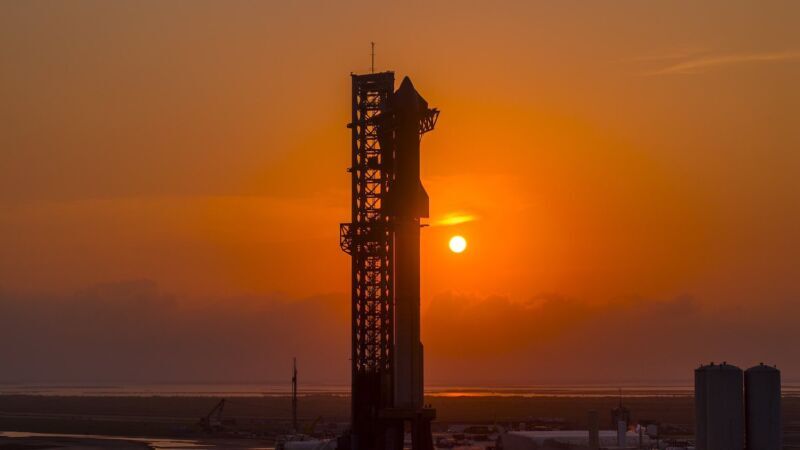
In a short video released Thursday, possibly to celebrate the US Fourth of July holiday with the biggest rocket's red glare of them all, SpaceX provided new footage of the most recent test of its Starship launch vehicle.
This test, the fourth of the experimental rocket that NASA is counting on to land its astronauts on the Moon, and which one day may launch humans to Mars, took place on June 6. During the flight, the first stage of the rocket performed well during ascent and, after separating from the upper stage, made a controlled reentry into the Gulf of Mexico. The Starship upper stage appeared to make a nominal flight through space before making a controlled—if fiery—landing in the Indian Ocean.
The new video focuses mostly on the "Super Heavy" booster stage and its entry into the Gulf. There is new footage from a camera on top of the 71-meter-tall first stage as well as a nearby buoy at water level. The video from the buoy, in particular, shows the first stage making an upright landing into the ocean.
Perhaps most intriguingly, at the end of the video, SpaceX teases an image of Starship's large launch tower in South Texas at the Starbase facility. Prominently featured are the two "chopsticks," large arms intended to catch the first stage booster as it slowly descends back toward its launch pad.
Then, in simulated footage, the video shows Starship's first stage descending back toward the launch tower with the title "Flight 5." And then it fades out.
To land, or not to land?
This supports the idea that SpaceX is working toward attempting a Starship booster catch on its next flight test, which likely will occur later this summer. Doubtless, the company still has both technical and regulatory work before this can happen.
In the days immediately following the fourth flight test, SpaceX founder Elon Musk said it was the company's goal to make such a landing attempt on the next launch. However, during a talk last week with local residents in south Texas, Starbase General Manager Kathy Lueders said this attempt might not occur on Flight 5.
However, the new video released Thursday indicates that a catch attempt is still on the table as a possibility, and perhaps even a likelihood. Such a landing would be both stunning visually, as well as a calculated risk to SpaceX's launch tower infrastructure, as the booster likely would be landing with a few spare tons of methane and liquid oxygen propellant in its tanks.
If SpaceX decides to press ahead with the attempt, it must still obtain a launch and reentry license from the Federal Aviation Administration, which is tasked with ensuring the safety of people and property on the ground. It seems probable that the next test flight will not occur before August.
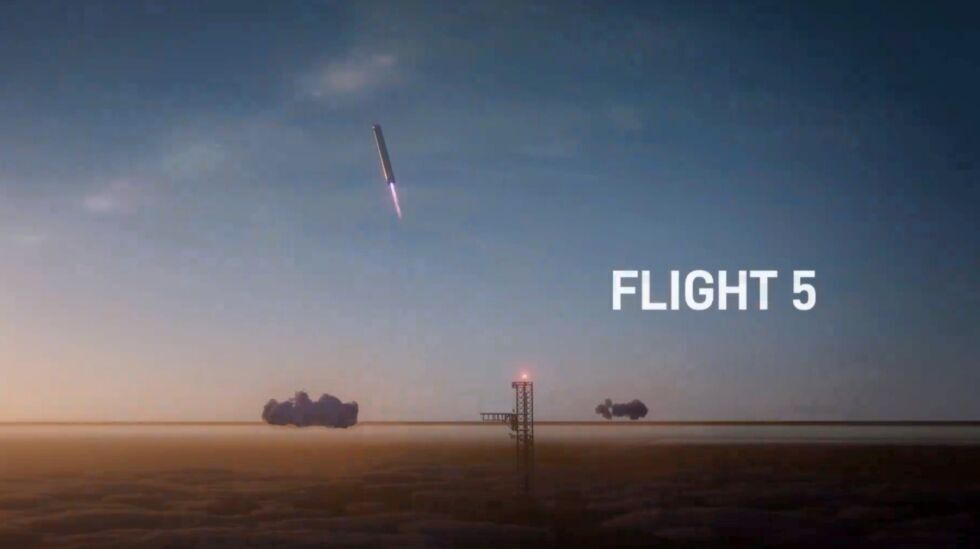
Meanwhile, activities at the South Texas launch site may well be curtailed for a couple of days as Hurricane Beryl enters the Gulf of Mexico later on Friday and then tracks toward the Texas coast early next week. The center of Beryl is expected to pass near or north of the launch site late on Sunday night or Monday, bringing winds and surges.
However, because Beryl is not expected to be a major hurricane in terms of wind speed, these impacts should not prove catastrophic to SpaceX facilities. Heavy rainfall and inland flooding in the low-lying Starbase area is also a possibility on Monday and Tuesday before the storm pulls away.
Quelle: arsTechnica
----
Update: 17.07.2024
.
SpaceX test-fires Super Heavy Starship booster ahead of 5th flight
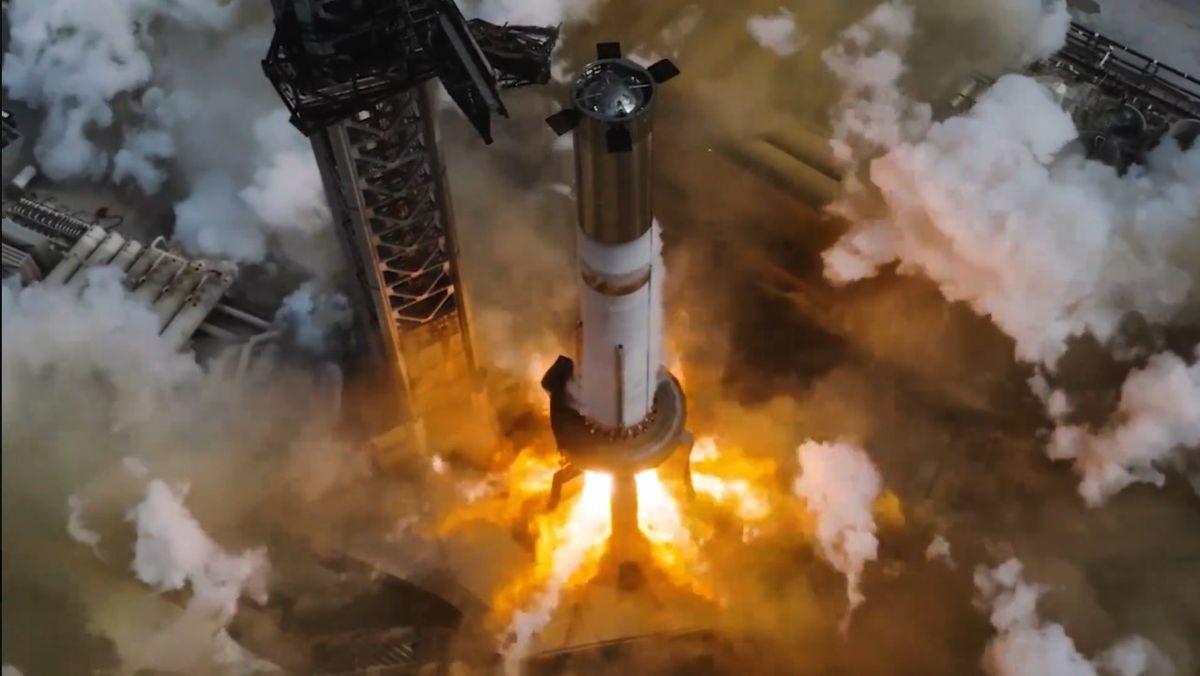
SpaceX's Super Heavy booster ignites its 33 Raptor engines during a static test fire July 15, 2024. (Image credit: SpaceX)
Each of Starship's four test flights has gone farther and accomplished more than its predecessor, with the rocket's the most recent launch in June being hailed as a complete success. That launch saw Starship and its Super Heavy booster both return, as planned, for controlled ocean splashdowns. Now, hoping to build on that success, SpaceX will attempt to reach even further on Starship's fifth flight.
Starship is designed to as a completely reusable system. Like the first-stage of SpaceX's Falcon 9 booster, Super Heavy is designed with grid fins to help control its reentry through the atmosphere, but unlike the current workhorse of SpaceX's fleet, when Super Heavy returns to land, the plan is for it to fly straight back to the pad where it launched.
The Starship launch tower features two massive "chopstick" arms that are designed to catch Super Heavy by its grid fins, as the booster arrests its momentum to a momentary standstill in midair to sucumb to the chopsticks' tender embrace. This way, in the efforts of rapid refurbishment, the booster is already where it needs to be in order to launch again.
During its fourth flight, though Super Heavy's landing burn over the ocean was nowhere near its launchpad in Starbase, Texas, SpaceX closed the launch tower's chopstick arms in conjunction with the booster's water landing, seemingly to test the system's timing and capabilities. Now, they're going to try it for real. Following the success of IFT-4, Musk wrote in a post on X, "aiming to try this in late July!" in response to a video featuring an animated Super Heavy booster catch.
As for when the next Starship launch will take place, on July 5, Musk said "four weeks," in a post on X. That timeline would put the launch around Aug. 2, however the rocket billionaire's estimates are often optimistically hopefull. So, at the earliest, we may see Starship IFT-5 liftoff around the beginning of August.
Quelle: SC
----
Update: 27.07.2024
.
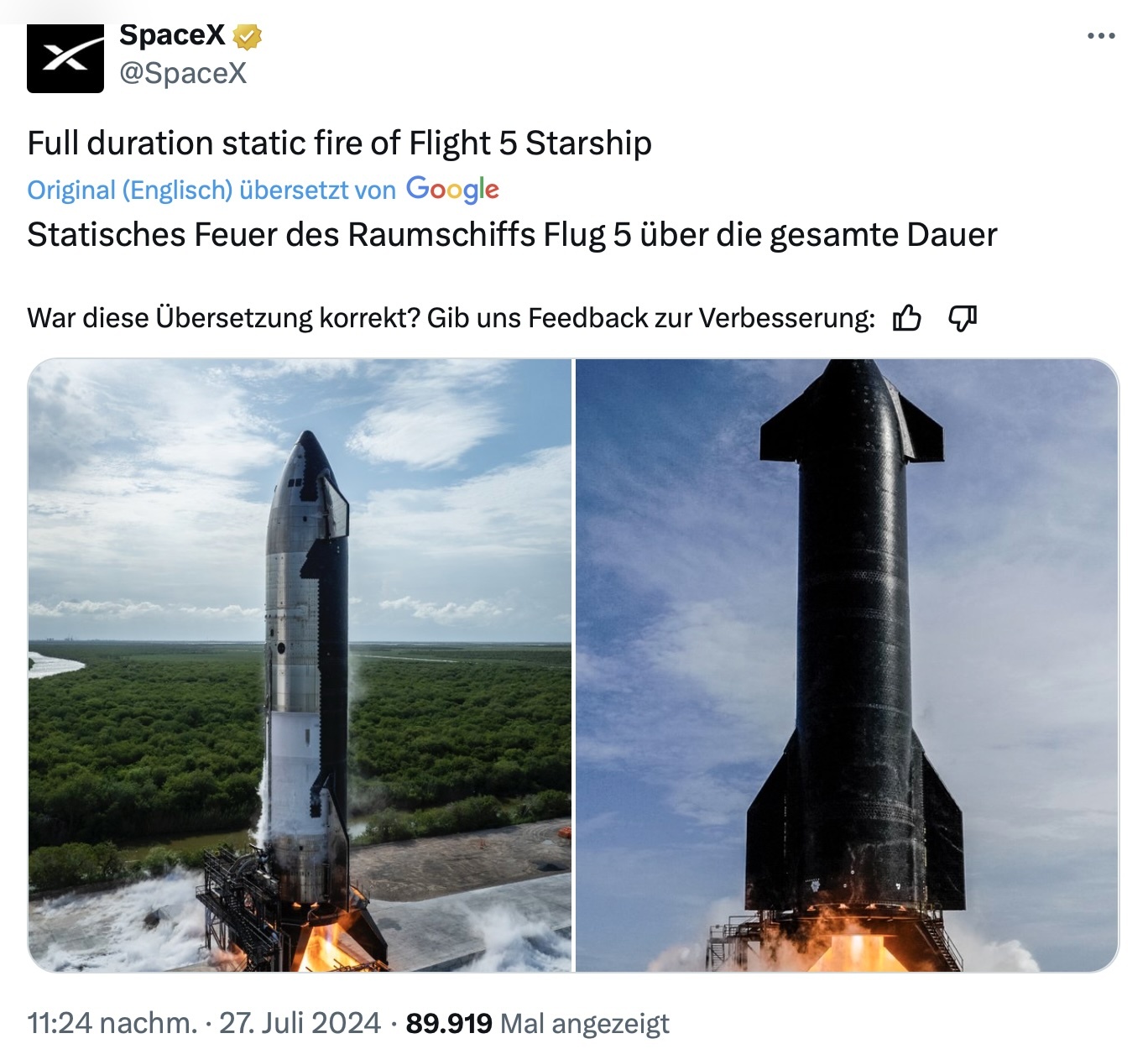
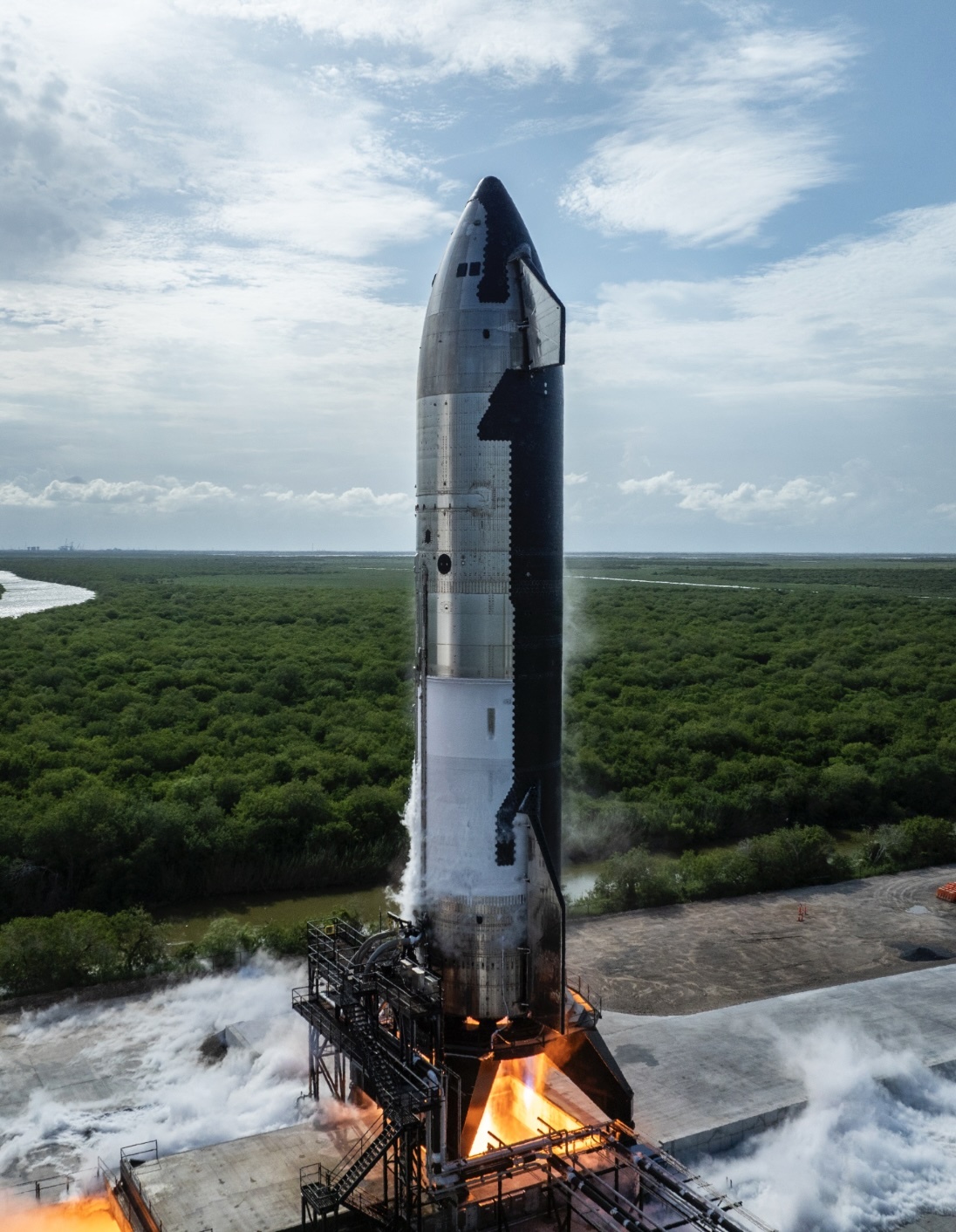
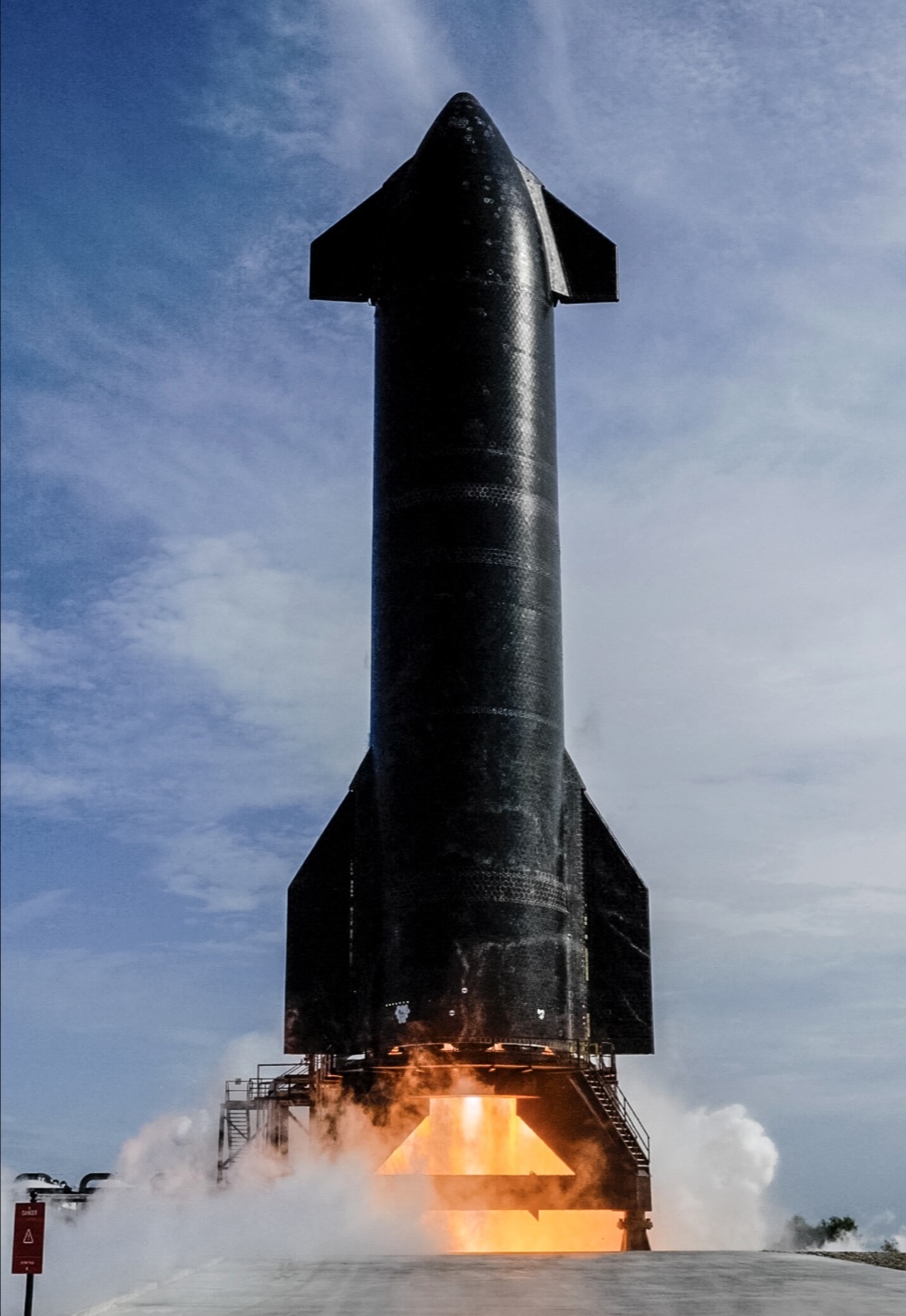
Quelle: X Twitter
----
Update: 3.08.2024
.
With each flight of Starship and the Super Heavy booster, we get closer to our goal of making life multiplanetary. The most important advancement to make this happen is full and rapid reusability of the entire launch system, operating Starship like an airplane which is fully and rapidly reusable after each flight. To do this, we have designed Starship’s upper stage and the Super Heavy booster to be capable of returning to the launch site. The returning vehicles will slow down from supersonic speeds, resulting in audible sonic booms in the area around the return location.
A sonic boom is a brief, thunder-like noise a person on the ground hears when an aircraft or other object travels faster than the speed of sound. As a fast-moving object travels through the air, it pushes the air aside and creates a wave of pressure which eventually reaches the ground. The change in air pressure associated with a sonic boom, known as overpressure, increases only a few pounds per square foot. A person could experience a similar pressure change by riding down several floors in an elevator. What makes sonic booms audible is the quick speeds at which the pressure change occurs.
Generally, the only impact to those in the surrounding area of a sonic boom is the brief noise. There are many variables that determine the impact of sonic booms, including the mass, shape and size of the object traveling at high speeds, along with its altitude and flight path. External factors like weather conditions can also affect the intensity of a sonic boom. The strongest effects of the sonic boom’s pressure change are localized to the area directly beneath the vehicle, concentrated under the rocket’s flight path and the landing site.
Sonic booms in spaceflight have typically only been experienced by observers on Earth when encountering vehicles designed to be reused, such as SpaceX’s Falcon family of rockets. When the first stage booster of a Falcon rocket returns for landing, its size and speed generate multiple sonic booms heard on the ground as a double clap of thunder. Similar sonic booms were heard during the return and landing of the NASA’s space shuttle. In each case, the sonic boom marks the end of just one in a series of missions for the vehicle returning from flight.
Data gathered from the first ever Super Heavy landing burn and splashdown on Starship’s fourth flight test indicates that while Super Heavy’s sonic boom will be more powerful than those generated by Falcon landings, it does not pose any risk of injury to those in the surrounding areas. The strongest effects will be localized to the area immediately around the Starbase launch pad. This area is cleared well in advance of launch and has been rigorously designed to withstand the environments of launching and returning the most powerful rocket ever flown.
Sonic booms announce the return of rockets and spacecraft built to be reused. With Starship, they’ll signal the arrival of a rapidly reusable future in spaceflight to travel to Earth orbit, the Moon, Mars, and beyond.
Quelle: SpaceX
+++
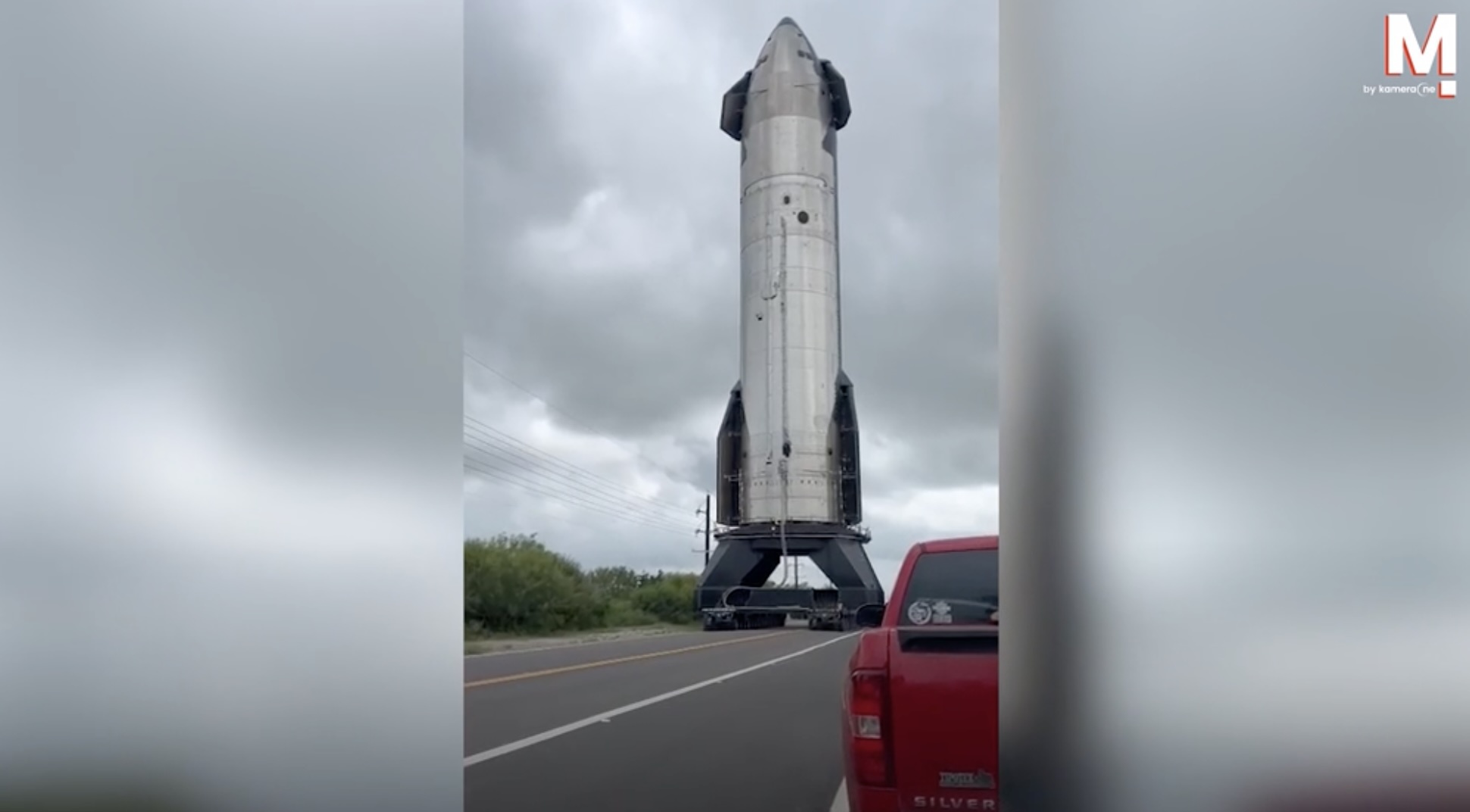

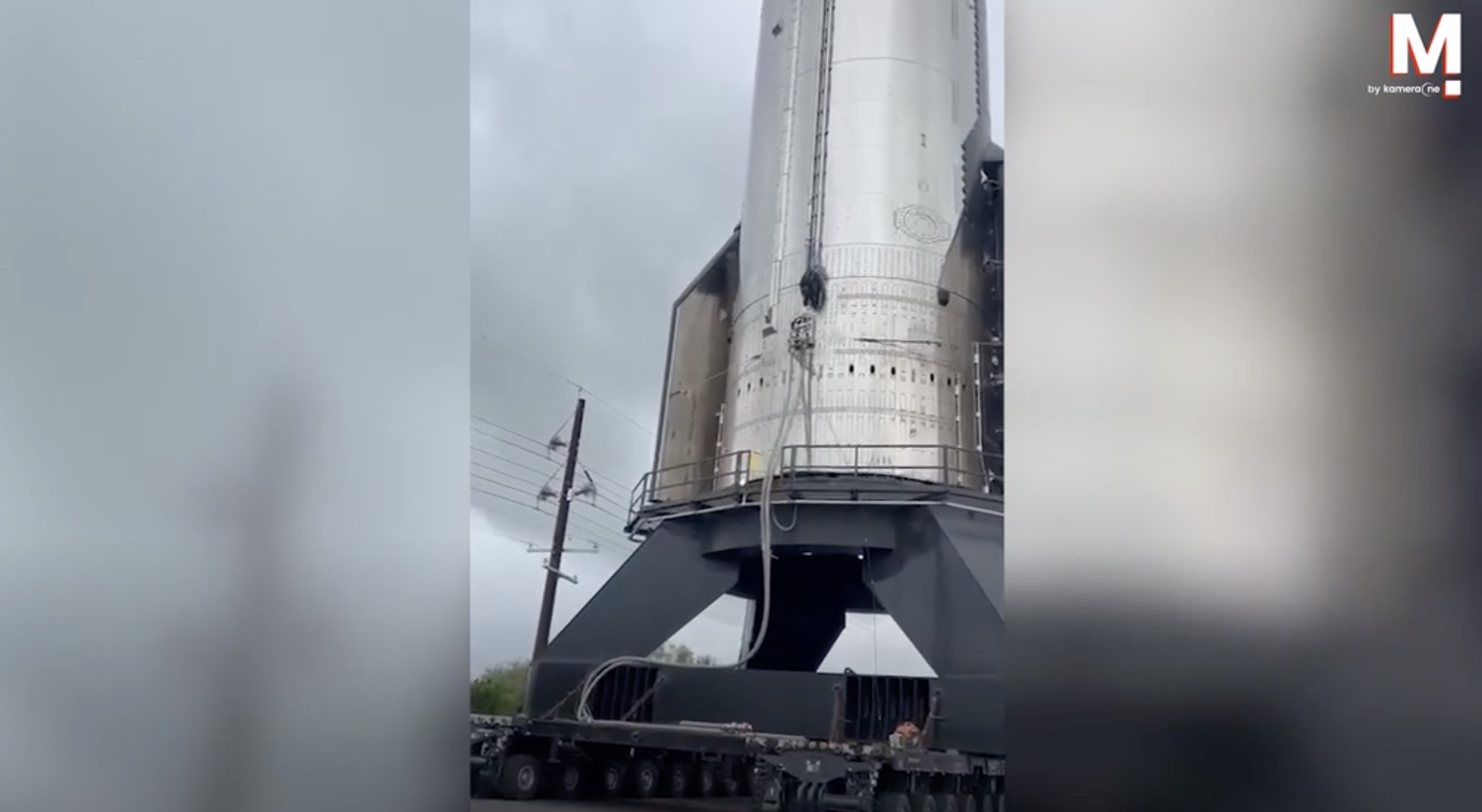
Quelle: t-online.de
----
Update: 11.08.2024
.
Flight 5 and 6 Preparations Underway as SpaceX reveals Raptor 3
SpaceX continues with the Starship pace, with another busy week involving the reveal and first firing of the Raptor 3 engine, a spin prime — and not a static fire — for Ship 30, tons more Orbital Launch Pad B work. SpaceX noted it is also working Flight 6 preparations while waiting for Flight 5 regulatory approval, which ups the milestones with a potential catch by the Tower’s Mechazilla chopsticks. Preparing for that goal is B14.1, out at Orbital Launch Pad A for more slap testing.
Ship 33 continues to be stacked, as only two sections remain until the first Block 2 ship is fully assembled. Those sections are the bottom Liquid Oxygen Tank section, slated to have four rings, and the aft engine section, which also has four rings. This will bring the number of rings for Block 2 Starships to 21, compared to 20 on Block 1 ships.
This extra ring and the ability to move the tanks allow SpaceX to add around 300 tons of extra propellant to the vehicle.
Recently, SpaceX revealed pictures and specifications of Raptor 3, which is slated to replace the current Raptor 2 on current vehicles. This engine is far more refined, with much of the external plumbing moved internally or removed altogether. A lot of the internal plumbing is regenerative cooling channels built into the engine’s case.
This allows SpaceX to run the engine with more pressure and eliminate the heavy heat shield currently used on Raptor 2.
Raptor 1 was used on the suborbital test flights and vehicles up to Booster 4 and Ship 20. This engine was still very much a prototype engine. It only had 185 metric tons of thrust and weighed a decent amount, with the engine being 2,080 kg and 3,630 kg when all vehicle-side commodities and hardware were added on.
Raptor 2 has been used since Booster 7 and Ship 24. So far, it has been the Starship program’s most produced engine, with at least 569 engines made and possibly a decent amount more. This engine runs at 230 metric tons of thrust and is much lighter than Raptor 1. The engine itself is 1,630 kg, and added vehicle-side committees and hardware bring it to 2,875 kg.
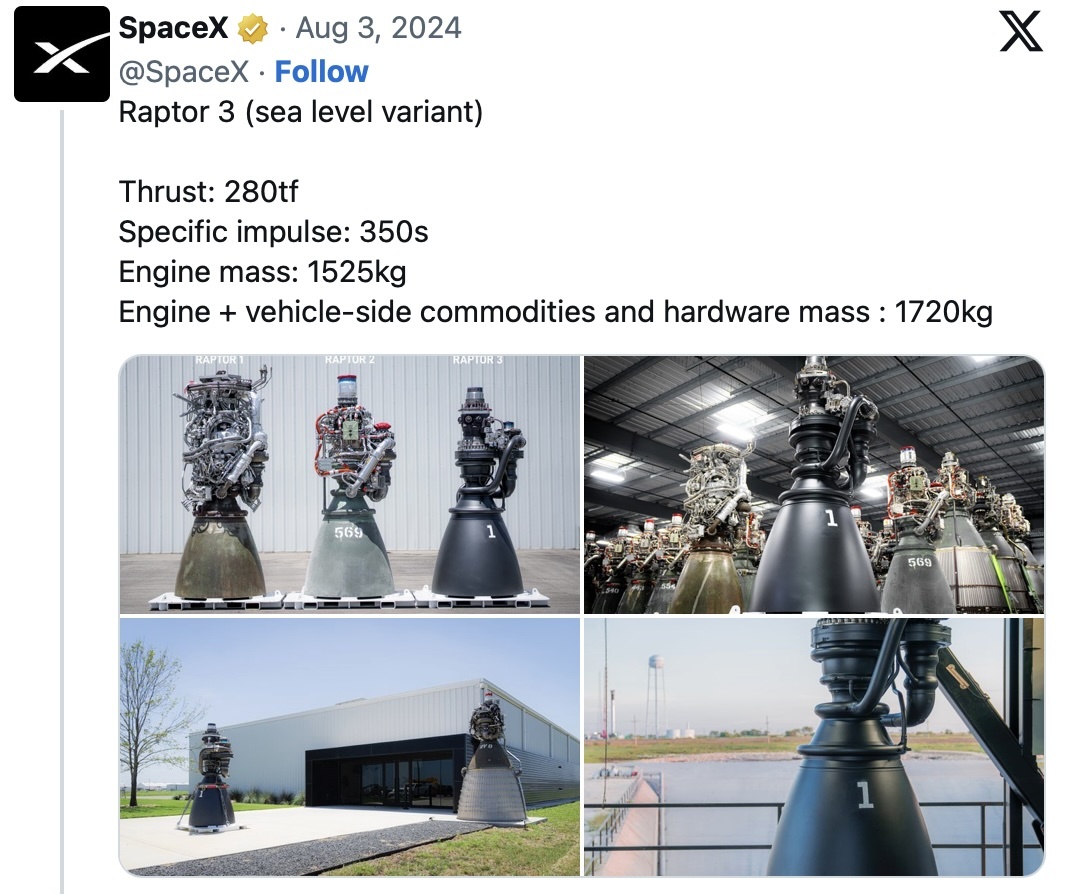
Now, Raptor 2 got Starship into space and has been very reliable during launches, with only a couple of failures on Flight 1 and two on Flight 4.
Then comes Raptor 3, which, based on pictures from SpaceX, is in the East bay of the Raptor Vertical test stand at McGregor, Texas. This engine is slated to have 280 metric tons of thrust and drastically reduce the weight needed to support it. The engine is slated to be 1,525 kg and, with added vehicle-side components, 1,720 kg.
As stated before, SpaceX can make it much lighter by removing heat shields. Looking at Raptor 3, it looks to be in two separate parts: a low-pressure side that still has flanges and seals and a high-pressure side on the bottom with no flanges. Removing flanges and those seals will allow SpaceX to run the engine at higher and higher pressures, which results in more thrust coming out of the engine.
It is unclear when this engine will be placed on a vehicle. SpaceX probably still needs more testing now that the design is somewhat finalized. As an added bonus, SpaceX Chief Operating Officer Gwynne Shotwell treated everyone to an amazing picture of Raptor 3 SN1 Static fire at McGregor.
Ship 30 did more engine testing this past week with a spin prime. This was required if another Raptort Vacuum Engine was swapped out, and R398 was swapped for R384. It is unknown why SpaceX swapped this engine out.
This time around, teams only completed a spin prime, as happened with Ship 28 after one of its Raptor Vacuum engines was swapped.
Ship 30 is back at the production site and on a ship transport stand. This ship should be getting its final touches, barring another engine change. Teams will finish the heat shield work and other final line items until Orbital Launch Pad A becomes available. Once out at the pad, Booster 12 and Ship 30 can complete a Wet Dress Rehearsal; however, it is unknown when or even if this will happen or how close to launch such a thing will be.
Regarding the readiness for Flight 5, SpaceX posted on social media that both Flight 5 vehicles are ready pending regulatory approval. This follows the just-completed spin prime Ship 30. Both Ship 30 and Booster 12 could be ready, but in the past, SpaceX has said this when, in fact, neither vehicle was actually ready for flight.
SpaceX also started to catch testing, and Flight 6 vehicle testing would occur while crews waited for approval. B14.1 is back at the Orbital Launch Mount (OLM) for said catch testing. However, Flight 6’s vehicles are occupied a bit at the moment.
Ship 31 just recently started getting its heat shield redone, like SpaceX did to Ship 30, which took about 38 days to complete. So, Ship 31 will be tied up in the High Bay tiling station for the foreseeable future.
As for Ship 31’s other half, Booster 13 has been on the center Mega Bay 1 work stand since finishing its cryogenic proof testing at the end of April. Teams currently have a tent built up on the forward dome of Booster 13, which alludes to possibly some major work with that booster. Also, Booster 13 still doesn’t have its grid fins.
Orbital Launch Pad B
Orbital Launch Pad B continues progressing, as the tower is now six modules tall. With the first six modules done, the CC8800-1 was laid down and is currently finishing its reconfiguration before being raised again to finish the tower. Modules 7, 8, and 9 have scaffolding on top and look to be ready for rollout and installation as soon as the crane is ready once again.
B14.1 The Slappening Part Deux Electric Boogaloo
Booster 14.1 was rolled back out to Orbital Launch Pad A ahead of what is assumed to be chopstick catch testing. At the end of June, B14.1 was mounted on the OLM and “slapped” by the chopsticks. This testing was to dial in the speed and control of the chopstick arms before a flight booster came in for a landing.
Teams also tested the landing rail system to ensure that the system could take the instant load required.
Since those tests, SpaceX has replaced many of the linkages to the landing rails on both arms and upgraded and added more landing rail actuators to both arms. This will help the rails take more force and be more controllable. Another big change is that teams are replacing and upgrading the bumper pads used to slap B14.1 in June.
While teams had replaced the actuator on the north side arm, crews only upgraded the main actuator on the south arm. So, both arms should be able to move at full speed once these changes are completed.
With all these changes, teams might do a clap test, which would be both arms coming in for a slap simultaneously, simulating a catch. The one other major thing SpaceX did not do during the last round of testing was slap and then bring up the arm in one full motion.
Quelle: NSF
